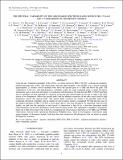THE SPECTRAL VARIABILITY OF THE GHZ-PEAKED SPECTRUM RADIO SOURCE PKS 1718-649 AND A COMPARISON OF ABSORPTION MODELS
Author(s)
Cappallo, Roger J.; Corey, Brian E.; Kratzenberg, Eric W.; Lonsdale, Colin John; McWhirter, Stephen R.; Rogers, Alan E. E.; Whitney, Alan R.; ... Show more Show less
DownloadTingay-2015-THE SPECTRAL VARIABI.pdf (540.4Kb)
PUBLISHER_POLICY
Publisher Policy
Article is made available in accordance with the publisher's policy and may be subject to US copyright law. Please refer to the publisher's site for terms of use.
Terms of use
Metadata
Show full item recordAbstract
Using the new wideband capabilities of the ATCA, we obtain spectra for PKS 1718-649, a well-known gigahertz-peaked spectrum radio source. The observations, between approximately 1 and 10 GHz over 3 epochs spanning approximately 21 months, reveal variability both above the spectral peak at ~3 GHz and below the peak. The combination of the low- and high-frequency variability cannot be easily explained using a single absorption mechanism, such as free–free absorption or synchrotron self-absorption. We find that the PKS 1718-649 spectrum and its variability are best explained by variations in the free–free optical depth on our line of sight to the radio source at low frequencies (below the spectral peak) and the adiabatic expansion of the radio source itself at high frequencies (above the spectral peak). The optical depth variations are found to be plausible when X-ray continuum absorption variability seen in samples of active galactic nuclei is considered. We find that the cause of the peaked spectrum in PKS 1718-649 is most likely due to free–free absorption. In agreement with previous studies, we find that the spectrum at each epoch of observation is best fit by a free–free absorption model characterized by a power-law distribution of free–free absorbing clouds. This agreement is extended to frequencies below the 1 GHz lower limit of the ATCA by considering new observations with Parkes at 725 MHz and 199 MHz observations with the newly operational Murchison Widefield Array. These lower frequency observations argue against families of absorption models (both free–free and synchrotron self-absorption) that are based on simple homogenous structures.
Date issued
2015-01Department
Haystack ObservatoryJournal
The Astronomical Journal
Publisher
IOP Publishing
Citation
Tingay, S. J., J.-P. Macquart, J. D. Collier, G. Rees, J. R. Callingham, J. Stevens, E. Carretti, et al. “THE SPECTRAL VARIABILITY OF THE GHZ-PEAKED SPECTRUM RADIO SOURCE PKS 1718-649 AND A COMPARISON OF ABSORPTION MODELS.” The Astronomical Journal 149, no. 2 (January 28, 2015): 74. © 2015 The American Astronomical Society
Version: Final published version
ISSN
1538-3881
0004-6256